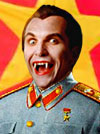|
Flowers from Hell: A Satanic Reader Book review by Thomas M. Sipos |
|
MENU Books Horror Film Festivals and Awards
Pursuits
Blogs Horror Film Festivals and Awards
Other
|
Flowers From Hell: A Satanic Reader (edited by Nikolas Schreck, Creation Books, 2001, 285 pp.)
Nikolas Schreck's "Satanic Reader" is an anthology tracing the development of Satan as a literary character in fiction and poetry. Most selections are excerpts from longer works (novels, plays, epic poems), beginning with Dante's Inferno and culminating in Michael A. Aquino's The Diabolicon (1970). Short stories and poems are reprinted in their entirety. As an anthology of old classics (Aquino is the only living contributor), the sole original content is Schreck's lengthy Introduction, which is instructive, if opinionated. Schreck provides historical context for each selection, but also critiques them from an iconoclastic perspective. One senses that Schreck admires Satan -- or at least the Satan concept. Schreck views Satan as a celebration of rebellion, individual liberation, courage, inspiration to artistic creation. And he argues that many authors and artists, throughout the centuries, have had "sympathy for the Devil." Schreck
writes:
The first selection in Flowers From Hell is an excerpt from Dante's Inferno. Schreck credits Dante with establishing Satan in the Western imagination. (The phrase: "All hope abandon ye who enter here" was coined by Dante.) Seven hundred years of Satanic depictions (by sincere Satanists, Christian preachers, heavy metal bands, and horror pulpsmiths) owe a debt to Dante. Wiccans and neo-pagans like to insist that Satan is not a pagan invention, but wholly a creation of Judaeo-Christianity. But Schreck demonstrates that Satan is both younger and older than the Bible. For while Dante created the modern image of Satan, the concept of an evil dark god -- a malevolent deity in opposition to the established social order -- predates Judaism. Satan's roots extend into paganism, and probably into prehistory. Schreck writes:
Here is
Schreck's remark, in context:
Does Schreck believe his own words? Or is he sophomorically trying to irritate Judaeo-Christian sensibilities, and in so doing, has inadvertently said more than he meant? I don't know. However, it is noteworthy that the late Anton Szandor LaVey espoused a similar nihilism in his Satanic Bible. In addition to Dante, Schreck credits three other authors with solidifying the modern image of Satan: Christopher Marlowe (The Tragical History of Doctor Faustus), John Milton (Paradise Lost), Johann Wolfgang von Goethe (Faust). Schreck writes that their works "are the four foundation stones upon which the modern Western image of Lucifer has been constructed. Without this quartet of poetic monoliths, the character of Satan would be nothing more than a dimly perceived aggregate comprised of a handful of Biblical references and a few colourful scraps of folklore."
After analyzing these four works, Schreck discusses Satan's depiction in Gothic Romanticism (the literary roots of supernatural horror), and Satan's changing portrayal by increasingly skeptical modern authors. Here is the complete list of contributors to Flowers From Hell: Dante, Christopher Marlowe, John Milton, Johann Wolfgang von Goethe, William Beckford, Matthew Gregory Lewis, Charles Maturin, Washington Irving, Edgar Allan Poe, Charles Baudelaire, Joris-Karl Huysmans, Mark Twain, Anatole France, Max Beerbohm, Aleister Crowley, and Michael A. Aquino. Aside from Biblical passages, I'd have included excerpts from the Koran (Schreck's Introduction refers to Islam's fallen angel, Eblis), The Devil and Daniel Webster, Rushdie's Satanic Verses, and LaVey's Satanic Bible. (Although the Satanic Bible was ghost written, LaVey is probably the best known Satanist among the populace, if not among scholars and occultists.) Flowers From Hell is beautifully bound, on heavy slick paper that will not yellow. Seventeen full-page, black-and-white Satanic illustrations through the ages: paintings, wood cuts, and an appropriate Art Nouveau ink drawing for an excerpt from Crowley's The Black Lodge. Nikolas Schreck is an informed authority on Satanic lore. In this same year, Creation Books has released another Schreck book: The Satanic Screen: An Illustrated Guide to the Devil in Cinema. Lavishly illustrated, in keeping with Creation Book's long tradition of quality film books. Flowers From Hell largely achieves its goal: tracing the literary development of Satan. One need not be a Satanist or nihilist to find it useful as a literary reference tool. As most of the selections are written in the turgid, wordy, purple prose of centuries past, teen "Satanists" may find goofy fun in reading aloud passages, but those of an MTV-attention span will find the book a struggle. Ironically, brighter teens may turn to the complete Paradise Lost, their interest having been piqued. Schreck says (hopefully, one senses) that we are living in a "post-Christian" era. An assertion, rather than a given -- which Flowers From Hell may make even less given. Nikolas Schreck, who lives in Europe, is doing a book tour in the US this October 2001. Review copyright by Thomas M. Sipos
|
"Communist Vampires" and "CommunistVampires.com" trademarks are currently unregistered, but pending registration upon need for protection against improper use. The idea of marketing these terms as a commodity is a protected idea under the Lanham Act. 15 U.S.C. s 1114(1) (1994) (defining a trademark infringement claim when the plaintiff has a registered mark); 15 U.S.C. s 1125(a) (1994) (defining an action for unfair competition in the context of trademark infringement when the plaintiff holds an unregistered mark).

